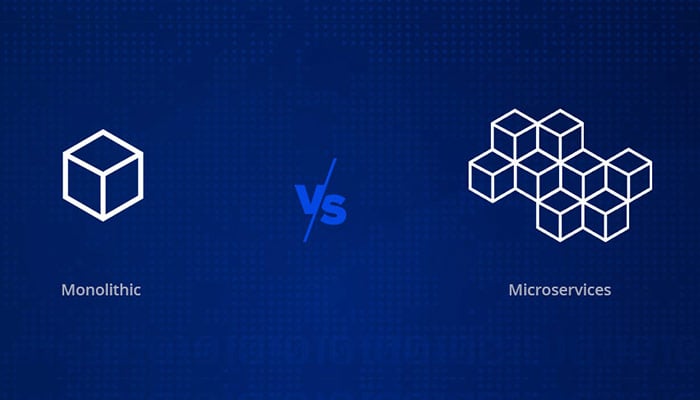Product Modernization | 12 Feb 2021 | 11 min
Monolithic v/s Microservices Architecture-Pick What’s Right for Your Business

In the recent past, we witnessed a rapid shift in the way IT companies approached application and software development owing to the increasing customer demands and complexities of applications. We’ve seen global leaders like Netflix, Amazon, Google, etc. switching from a monolithic architecture to a microservices driven approach and with such giants paving the way, more and more companies are jumping on the microservices bandwagon.
This blog breaks down the key differences between monolithic and microservices driven architectures which will allow you to make an informed decision before you dive in head-first into the realm of microservices.
To understand microservices, we first need to learn about the conventional approach that companies have adopted for application development–monolithic architecture. A monolithic architecture is one that is designed to handle multiple tasks that are related to one another. A monolith consists of n-number of modules of an application that are contained in a single unit. These modules can be divided for business features or technical features. Traditionally, applications are build using a monolithic architecture as a single large system with one code base. This basically means that the entire app, with its relevant functionalities, is deployed at the same time and wherever a need for scaling arises, we can simply add extra nodes.
In a monolith, all modules are tightly coupled and are built using a single stack. The components of a monolith are heavily inter-dependent and often function in tandem with one another.
An easy way to understand a monolith would be to think of an eCommerce SaaS application containing various tightly coupled components such as a web server, catalogue server, ordering system, payment gateway function, and a shipping component that are dependent on each other.
A monolithic architecture is preferred in some cases since it is:
However, on the flip side there are some things that may tie you down when it comes to monolithic architecture:
Simply put, a microservice architecture is equivalent to a monolith disassembled into its constituent modules, each of which is set down in its own container-run service. These containers are developed, run, maintained separately, and communicate with each other over APIs. As opposed to monolithic architecture, microservices favor the independent deployment of smaller constituents that are loosely coupled and tied together through application integration.

Microservices are easy to develop owing to their small scope and size and the developer can use any programming language of their choice to build them. This also means that when extra nodes are added for scaling, they can be developed using a different language than that used for the primary constituent.

Improvements and updates in microservices architecture can be done through CI/CD channels which enables relevant scaling. Since all the services are independent entities, it is possible to horizontally scale the application with ease.
You can understand microservices architecture by considering an example of a ticket booking platform wherein there will be independent services such as slot selection, ticket reservation, ticket booking, payment gateway, etc. that work in conjunction with each other through predefined interfaces.
Now, after understanding the What of microservices, let me tell you some of the Whys. With microservices, you will get:
I am not here doing a paid ad in favor of microservices architecture. It also comes with its own set of drawbacks. So, let me list out some of the minuses :
After studying the various characteristics, advantages, and disadvantages of both monolithic and microservices architecture, we can circle back to what my title read, Monolith vs Microservices architecture and which one should you choose?
Here are my two cents:
If you are starting your application development journey from scratch, and want to build a simple, lightweight app, go with a monolithic approach. This will allow you to comfortably dip your toes in the waters of application development in a cost-effective manner. However, as the processes in your application get more complex and scaling becomes a necessity, it is better to switch over to a microservices approach since it can tolerate layered codes and often outperforms a monolith under heavy loads.
Adding some closing thoughts on this topic, I can’t stress enough on how developing complex applications is inherently challenging and so is selecting an architecture that best aligns with the objectives and culture of your business. And while it would be unfair for me to say that one approach is decisively better than the other, you should know that the one you choose is crucial in deciding whether or not it will support smooth development, deployment, scaling, troubleshooting, maintenance, etc. for your end product.
Reach out to us to know more about services, or read our micro guide to understand more about Microservices and the numerous attributes of microservices architecture as well as the various approaches for implementing microservices to upgrade the way you build applications.

we'll keep you in the loop with everything that's trending in the tech world.
